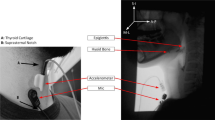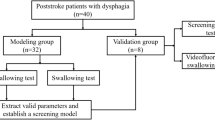Abstract
In this study, the feasibility of acoustical analysis for detection of swallowing silent aspiration is investigated. As a pilot study, we analyzed the breath sounds of 21 dysphagic individuals, 11 of which demonstrated aspiration during the fiberoptic endoscopic evaluation of swallowing (FEES) or videofluoroscopic swallowing study (VFSS). We found that the low frequency components of the power spectrum of the breath sounds after a swallow show higher magnitude when there is aspiration. Thus, we divided the frequency range below 300 Hz into three sub-bands and calculated the average power of the breath sound signal in each sub-band as the characteristic features for the stage 1 classification into two groups of aspirated and non-aspirated patients. Then, for the aspirated group, the unsupervised fuzzy k-means clustering algorithm was deployed to label the breath sounds immediately after a swallow as aspiration or non-aspiration. The results were compared with the FEES/VFSS assessments provided by the speech language pathologists. The results are encouraging: more than 86 % accuracy in detection of silent aspiration. While the proposed method should be verified on a larger dataset, the results are promising for the use of acoustical analysis as a clinical tool to detect silent aspiration.







Similar content being viewed by others
References
Aboofazeli M, Moussavi Z (2005) Analysis and classification of swallowing sounds using reconstructed phase space features. In: Proc IEEE Int Conf Acoust Speech, Signal Process (ICASSP), pp 421–424
Aboofazeli M, Moussavi Z (2006) Analysis of temporal pattern of swallowing mechanism. In: Proc IEEE Int Conf Eng Med Biol Soc (EMBS), pp 5591–5594
Ayappa I, Rapoport DM (2003) The upper airway in sleep: physiology of the pharynx. Sleep Med Rev 7(1):9–33
Bezdek JC (1981) Pattern recognition with fuzzy objective function algorithms. Plenum Press, New York, p 272
Blevins RD (1990) Flow-induced vibration, 2nd edn. Van Nostrand Reinhold, New York
Borr C, Hielscher-Fastabend M, Lücking A (2007) Reliability and validity of cervical auscultation. Dysphagia 22:225–234
Dempsey JE, Vice FL, Bosma JF (1990) Combination of cervical auscultation and videoradiography in evaluation of oral and pharyngeal dysphagia, [abstract] In: Symposium on Dyspbagia, Johns Hopkins Hospital
Duda RO, Hart PE, Stork DG (2000) Pattern classification. Wiley, Carrollton, p 654
Hamlet SL, Penney D, Formolo J (1994) Stethoscope acoustics and cervical auscultation of swallowing. Dysphagia 9(1):63–68
Hamlet SL, Patterson RL, Fleming SM, Jones LA (1992) Sounds of swallowing following total laryngectomy. Dysphagia 7(3):160–165
Jones B (2002) Normal and abnormal swallowing: imaging in diagnosis and therapy. Springer, New York, 287 pp
Kleinstreuer C, Zhang Z (2003) Laminar-to-turbulent fluid-particle flows in a human airway model. J. Multiph Flow 29:271–289
Lazareck L, Moussavi Z (2004) Classification of normal and dysphagic swallowing sounds by acoustical means. IEEE Trans Biomed Eng 51(12):2013–2112
Lazarus C, Logemann JA (1987) Swallowing disorders in closed head trauma patients. Arch Phys Med Rehabil 68:79–84
Lee J, Steele CM, Chaua T (2011) Classification of healthy and abnormal swallows based on accelerometry and nasal airflow signals. Artif Intell Med 52:17–25
Lee J, Blain S, Casas M, Kenny D, Berall G, Chau T (2006) A Radial basis classifier for the automatic detection of aspiration in children with dysphagia. J. Neuroengineering Rehabil 3(14):1–17
Leslie P, Drinnan MJ, Finn P, Ford GA, Wilson JA (2004) Reliability and validity of cervical auscultation: a controlled comparison using video fluoroscopy. Dysphagia 19(4):231–240
Lim S, Lieu PK, Phua SY, Seshadri R, Venketasubramanian N, Lee SH, Choo P (2001) Accuracy of bedside clinical methods compared with fiberoptic endoscopic examination of swallowing (FEES) in determining the risk of aspiration in acute stroke patients. Dysphagia 16(1):1–6
Logeman JA (1998) Evaluation and treatment of swallowing disorder. Pro-Ed, Austin, p 406
Luo XY, Hinton JS, Liew TT, Tan KK (2004) LES modeling of flow in a simple airway model. J Med Eng Phys 26:403–413
Mackay LE, Morgan AS, Bernstein BA (1999) Swallowing disorders in severe brain injury: risk factors affecting return to oral intake. Arch Phys Med Rehabil 80:365–371
Martino R, Pron G, Diamant N (2000) Screening for oropharyngeal dysphagia in stroke: insufficient evidence for guidelines. Dysphagia 15(1):19–30
Martino R, Foley N, Bhogal S, Diamant N, Speechley M, Teasell R (2005) Dysphagia after stroke: incidence, diagnosis, and pulmonary complications. Stroke 36(12):2756–2763
Panther C (2005) Development of the Frazier free water protocol. Dysphagia 14(1):4–9
Pope SP (2000) Turbulent flows. Cambridge University Press, Cambridge, p 771
Ramsey D, Smithard D, Kalra L (2003) Early assessments of dysphagia and aspiration risk in acute stroke patients. Stroke 34:1252–1257
Rempel G, Moussavi Z (2005) The effect of viscosity on the breath swallow pattern of young people with cerebral palsy. Dysphagia 20(2):108–112
Sarraf Shirazi S, Moussavi Z (2011) Acoustical modeling of swallowing mechanism. IEEE Trans Biomed Eng 58(1):81–87
Stroud AE, Lawrie BW, Wiles CM (2002) Inter- and intra-rater reliability of cervical auscultation to detect aspiration in patients with dysphagia. Clin Rehabil 16:640–645
Windham MP (1982) Cluster validity for the fuzzy C-means clustering algorithm. IEEE Trans Pattern Anal Mach Intell PAMI-4 4:357–363
Yadollahi A, Moussavi Z (2007) Feature selection for swallowing sounds classification. In: Proc IEEE Int Conf Eng Med Biol Soc (EMBS), pp 3172–3175
Zenner PM, Losinski DS, Mills RH (1995) Using cervical auscultation in the clinical dysphagia examination in long-term care. Dysphagia 10(1):27–31
Acknowledgments
This study was supported financially in part by the Natural Sciences and Engineering Research Council (NSERC) of Canada and Riverview Health Centre (Winnipeg). The authors would like to acknowledge A. Meakin and all the speech language pathologists in DeerLodge Health Center and Riverview Health Centre for their help in recruiting patients and collecting data.
Author information
Authors and Affiliations
Corresponding author
Rights and permissions
About this article
Cite this article
Sarraf Shirazi, S., Buchel, C., Daun, R. et al. Detection of swallows with silent aspiration using swallowing and breath sound analysis. Med Biol Eng Comput 50, 1261–1268 (2012). https://doi.org/10.1007/s11517-012-0958-9
Received:
Accepted:
Published:
Issue Date:
DOI: https://doi.org/10.1007/s11517-012-0958-9




